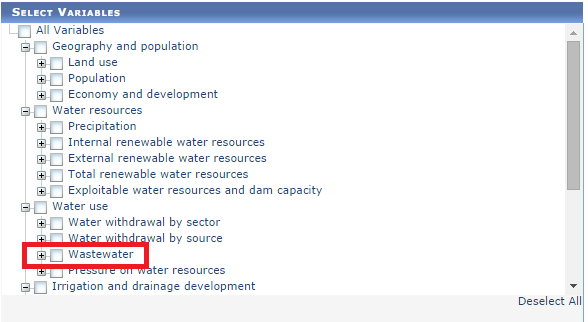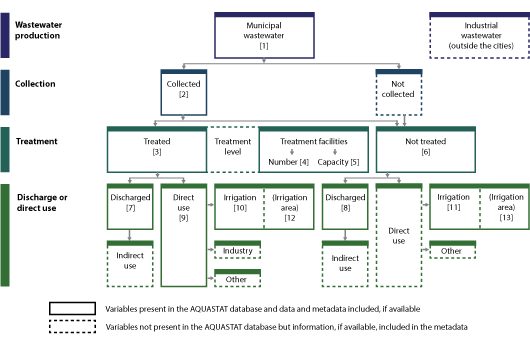AQUASTAT - FAO's Global Information System on Water and Agriculture
Wastewater
AQUASTAT is one of the largest global repositories of wastewater data, something increasingly important in view of the SDG 6.3 baselines, targets and monitoring. It collects, analyses and validates the best available data on municipal wastewater production, collection, treatment, discharge and direct use for irrigation purposes. While other existing wastewater databases often focus on percentage of sanitation coverage or pollution loads, AQUASTAT focuses on annual volumes at national level. The reason for choosing volume as the parameter to report is to facilitate the integration of these data in the water resources and use accounts in the different countries. At the end of 2013, AQUASTAT also started collaborating with the International Water Management Institute (IWMI) to collect, analyze and validate the best available data on municipal wastewater production, collection, treatment, discharge and direct use for irrigation purposes. The results of this collaboration are available in AQUASTAT, also announced on IWMI's website.
As of October 2016, about 2 300 municipal wastewater-related data points and 1 300 metadata are available in the Main Database.
Country profile and Regional analysis
AQUASTAT does not have a wastewater section per se in the country profiles and in the regional analysis, and not for all countries information on wastewater is available. When is available, this information can be found in either the "Water resources" or the "Water use" section of the profiles, for example using the expression "Other sources of water" or "Non-conventional sources of water".
Thematic discussion
While other existing wastewater databases often focus on percentage of sanitation coverage or pollution loads, AQUASTAT focuses on annual volumes at national level. The reason for choosing volume as the parameter is to facilitate the integration of these data in the water resources and use accounts in the different countries.
The diagram put further below illustrates the flow of wastewater from production to use. The variables squared in blue in that diagram are available by opening the wastewater category in the AQUASTAT Main Database, shown below.
The variables [1]-[11] can be accessed under the category "Wastewater" and have the unit km3/year or 10^9 m3/year, except for variable [4], which refers to the number of treatment facilities. The variables [12]-[13] can be accessed both under the category "Wastewater" and under the category "Irrigation and drainage development", sub-category "Area equipped for irrigation by source of water", and have the unit 1000 ha. Information on the level of treatment is, if available, provided in the metadata of the variable "Treated municipal wastewater" [3].
Click on the chart to magnify
Data sources, selection and validation
Data collection takes place through review of country briefs and national reports, databases, technical reports, peer-reviewed publications, information provided by national experts, presentations from national authorities in seminars, Internet search, etc.
Since data come from many different sources, inconsistencies may occur over the course of time. Therefore, each time new data become available a detailed review and validation of all data, both new ones obtained and the ones already available in the database, is essential.
Data is validated in relation to a time span from 1958 to 2012, based on the assumption that mainly the annual volume of wastewater produced, but probably also the annual volume collected, treated, discharged or directly used should - unless justified, such as for example due to contraction in the municipal population growth - show incremental increase as water use would rise over time.
Data is also validated in relation to various stages of the wastewater cycle, i.e. wastewater production (assumed to be the highest volume), wastewater collection, treatment and direct use (lowest volume of water).
Selected publications
A list of all publications is available on the Publications page. A non-exhaustive selection of some publications more specifically related to this page is given below:


